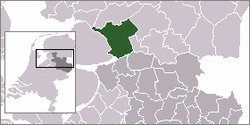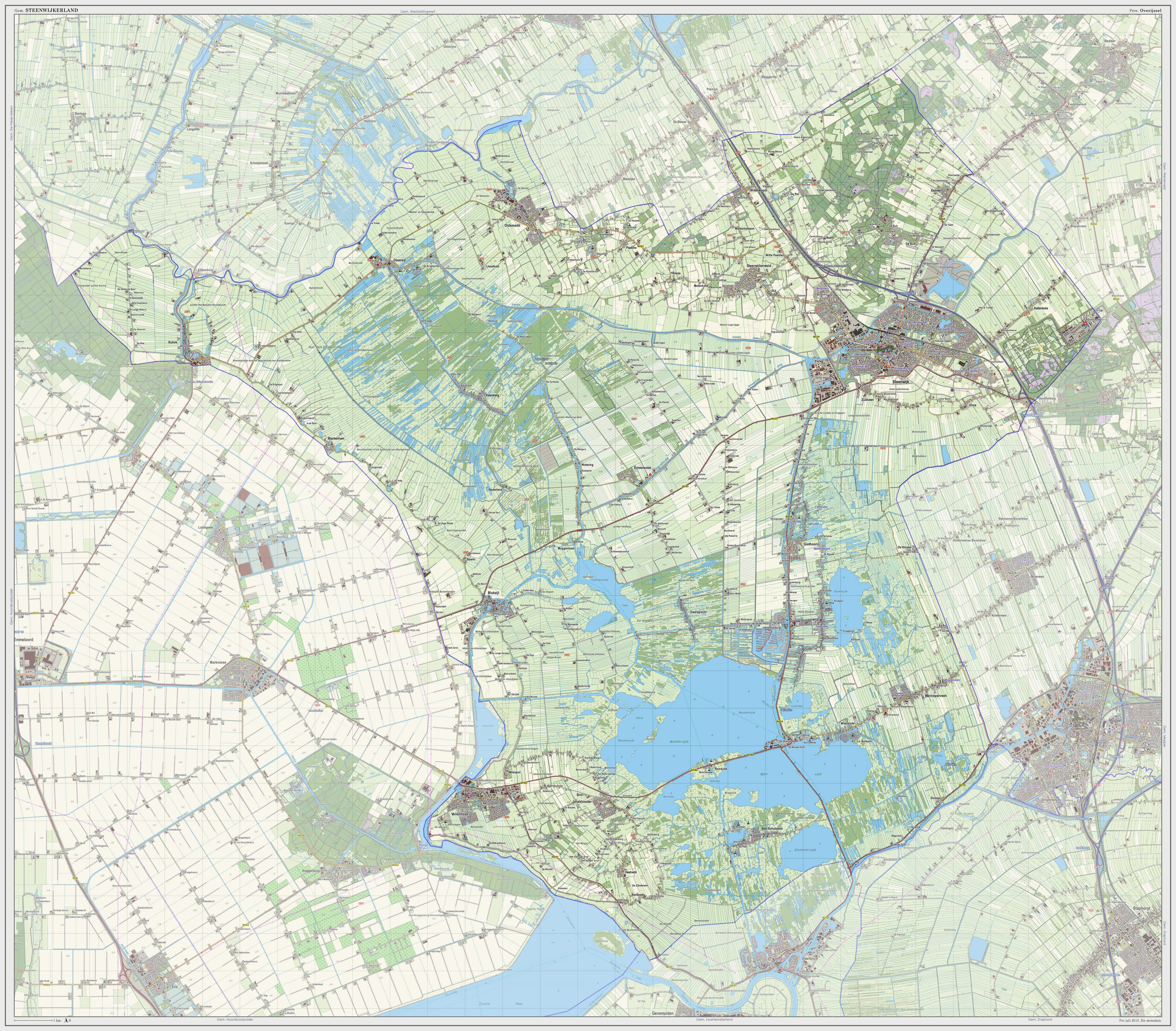Steenwijkerland
| Steenwijkerland | ||
|---|---|---|
| Municipality | ||
 | ||
| ||
 | ||
| Coordinates: 52°45′0″N 6°1′0″E / 52.75000°N 6.01667°E | ||
| Country | Netherlands | |
| Province | Overijssel | |
| Region | Kop van Overijssel | |
| Government | ||
| • Mayor | Marja van der Tas (CDA) | |
| Area(2006) | ||
| • Total | 321.69 km2 (124.21 sq mi) | |
| • Land | 291.12 km2 (112.40 sq mi) | |
| • Water | 30.56 km2 (11.80 sq mi) | |
| Population (1 January, 2007) | ||
| • Total | 43,119 | |
| • Density | 148/km2 (380/sq mi) | |
| Source: CBS, Statline. | ||
| Time zone | CET (UTC+1) | |
| • Summer (DST) | CEST (UTC+2) | |
 Steenwijkerland (
Steenwijkerland (![]() pronunciation (help·info)) is a municipality in the province Overijssel, in the eastern Netherlands. It was called Steenwijk before 2003.
pronunciation (help·info)) is a municipality in the province Overijssel, in the eastern Netherlands. It was called Steenwijk before 2003.
The municipality forms the entire northwesterly corner of the province. This area is called "the Head of Overijssel" (in Dutch: de Kop van Overijssel). It borders the province Friesland. The "capital" of the municipality, Steenwijk, with a population of about 17,100, is situated on the A32 motorway ( Zwolle – Meppel – Leeuwarden) and has a railway station on the line connecting those same cities.
Economy
Steenwijk is the economic and administrative centre of the region. Many smaller trading and industrial enterprises are housed here, as well as a hospital and some secondary schools.
Vollenhove has a shipyard, where very exclusive yachts are built.
All over the area, partially being below sea level, the soil is somewhat swampy. Many Steenwijkerland farmers only raise cattle. The soil is too wet to grow corn or wheat. However, the wetlands also have an advantage: many nature- or water sports-loving tourists come to the municipality.
Population centres
The more important places are printed in bold type. In brackets: estimated population, on January 1, 2006.
- Baarlo
- Baars
- Barsbeek
- Basse
- Belt-Schutsloot
- Blauwe Hand
- Blokzijl (1,400)
- De Bult
- De Klosse
- De Kolk
- De Pol
- Doosje
- Dwarsgracht – like Nederland and Muggenbeet, a small village much like Giethoorn, however more remote
- Eesveen
- Giethoorn (2,600)
- Heetveld
- Kadoelen
- Kalenberg
- Kallenkote
- Kuinre
- Leeuwte
- Marijenkampen
- Moespot
- Muggenbeet
- Nederland, Overijssel
- Oldemarkt (2,600)
- Onna, Overijssel
- Ossenzijl
- Paasloo
- Roekebosch
- Ronduite
- Scheerwolde
- Sint Jansklooster (2,400)
- Steenwijk (17,100)
- Steenwijkerwold (1,900)
- Tuk – like Zuidveen now a suburb of Steenwijk (1,600)
- Vollenhove (4,100)
- Wanneperveen (1,600)
- Wetering
- Willemsoord
- Witte Paarden
- Zuidveen
Sights
- The city of Steenwijk can be visited for daily shopping, going to the market, etc. Don't expect exclusive or extremely "trendy" shops!
- In Steenwijk the villa "Ramswoerthe", built in 1899 in Jugendstil architecture, and its park can be visited.
- Blokzijl has a small marina, surrounded by picturesque old brick houses from the 17th century, looking like miniatures of the Amsterdam canal houses.
- Vollenhove has two remarkable old churches (15th and 17th century), the castle ruins of Toutenburg with a park, the estate Old Ruitenborgh (18th century; small hotel with a good restaurant) and several old houses, of which the former Latin School (17th century) is the most beautiful.
- Giethoorn and Dwarsgracht are picturesque due to their local structure (see above); many of the old farmhouses have been transformed into "second homes" where rich Dutchmen live during their holidays. In summer, most houses of the village are lit in the evening, which enables the Tourist Board to organise romantic guided boat tours. Of course, a yacht-basin, restaurants and camping sites are there as well.
- Between Kuinre and Steenwijk lies the National Park "De Weerribben", a very valuable wetland area with bogs, swamps, small canals and meadows. It can be visited on guided tours. The entrance is in Ossenzijl. For information ask the VVV (Tourist Board) or the owner, the "Natuurmonumenten" organization (on their website, type under: Zoeken ( = Search) the name of the area).
- A similar natural reserve called "De Wieden" is situated in the southern part of the municipality. An information centre is situated in St. Jansklooster near Vollenhove. "Wieden" means: wide places, wide lakes. These lakes are suitable for sailing, windsurfing etc.
External links
| Wikimedia Commons has media related to Steenwijkerland. |
- Official website (only Dutch)
- National Park De Weerribben (partially in English)
 |
De Friese Meren (FR) | Weststellingwerf (FR) |  | |
| Noordoostpolder (FL) | |
Westerveld (DR) Meppel (DR) | ||
| ||||
| | ||||
| Zwartewaterland | Staphorst |
| |||||||||||

